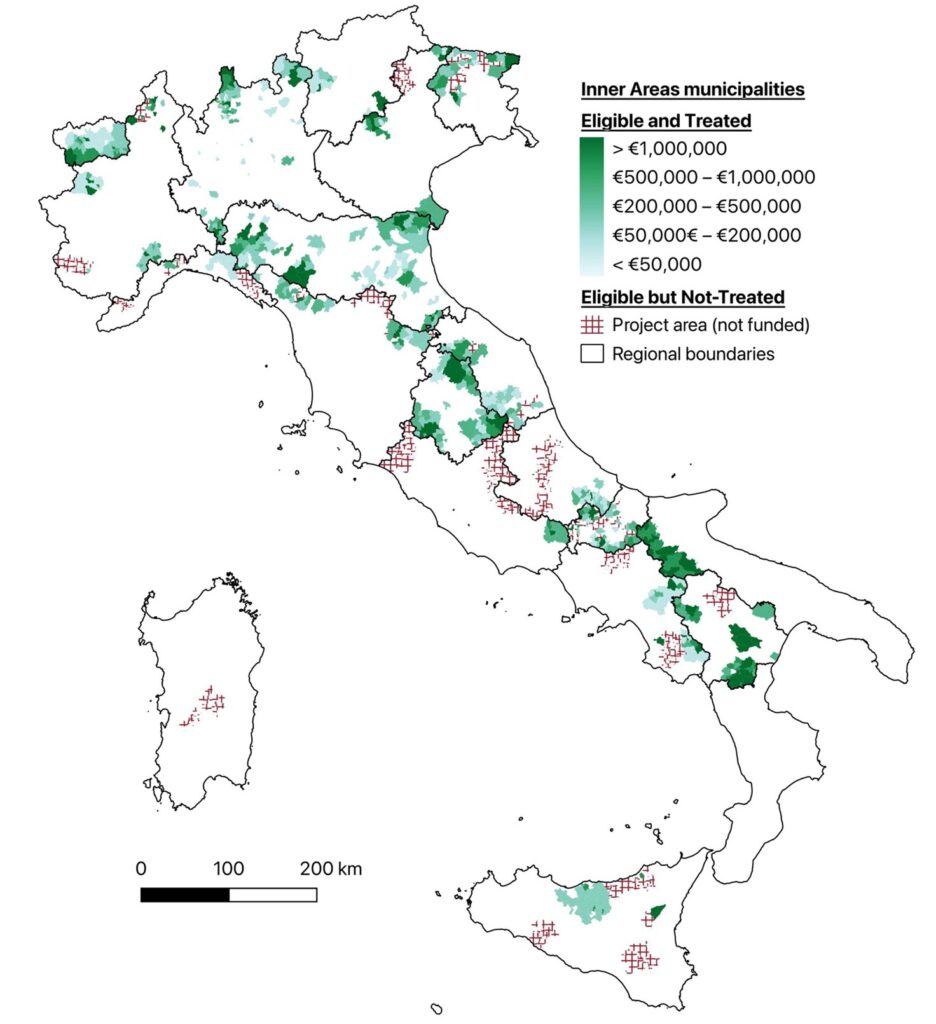Regional implications of the Italian inner areas strategy

By Dante Di Matteo (email) (eCampus University of Novedrate (Como) Italy; and CiMET, Italy’s National University Centre for Applied Economic Studies).
The need to evaluate the impact of public policies on tourism has become increasingly important over time (Aguinis et al., 2023). Tourism is a direct target of policies and frequently serves to achieve broader objectives, including economic and social cohesion, environmental sustainability, and regional development (Joppe, 2018). This approach is evident, for example, in the European Union’s Cohesion Policy, where tourism is included across different areas of intervention, even though it is not an explicit priority. However, measuring the effectiveness of tourism policies can prove challenging, especially at the local level, where adequate data and rigorous evaluation approaches are often lacking (Brandano & Crociata, 2023). The extant literature predominantly focuses on regional analyses (Deng et al., 2019) or uses descriptive methodologies, neglecting to estimate robust causal effects.
To fill this gap, the study “Regional implications of the Italian Inner areas strategy”, Regional Studies, 1–16, evaluates the impact of the National Strategy for the Inner Areas (SNAI)—a place-based policy introduced in Italy to revitalise marginal areas far from service centres—leveraging the tourism sector at the municipal level to perform initiatives and projects based on public subsidies.
SNAI is based on a funding mechanism aligning with the European Structural Funds, wherein eligibility is contingent upon compliance with specific criteria. Certain municipalities within each designated inner area receive substantial funding, while others, even those in close proximity, receive less or no funding at all. This results in an uneven distribution of funding intensity, which can be exploited to assess the impact of the policy. As visible in Figure 1, from 2014 to 2022, approximately €306 million was allocated to 701 Italian municipalities, many of which identified tourism as a primary project objective.

Figure 1. Geography of the Inner Areas’ transfers in Italy.
Note: Data was updated to 2022 and is navigable at this link. Author elaboration on SNAI data.
The outcome variable considered here is the annual tourist nights spent for each municipality, analysed overall and disaggregated between Italian and foreign tourists. The municipalities’ characteristics were integrated using a set of economic, social, and environmental control variables.
To evaluate the SNAI’s, a counterfactual approach based on quasi-experimental methods was adopted. The core of the analysis revolves around a difference-in-differences (DID) model, which compares the treated municipalities with a control group of eligible but unfunded municipalities. This allows the causal effect of the policy to be isolated, while verifying the hypothesis of parallel trends in the pre-intervention period.
Estimates reveal that the SNAI has significantly increased the overall number of nights spent in the municipalities involved –an effect mainly driven by domestic tourism– with particular emphasis starting from the second year after the policy outset. Additive estimations revealed substantial regional differences: mountain municipalities and those with a predominant cultural vocation have exhibited a marked positive impact. At the same time, those in the hills appear to be negatively affected with regard to domestic nights spent. Geographically, the northern regions benefited mainly in terms of foreign tourism, while southern and insular regions have witnessed a greater increase in domestic tourism. Central Italy, conversely, shows no statistically significant variations.
A further salient distinction pertains to the mechanisms through which the SNAI operated. Though significant structural projects have been financed, such as infrastructure or residential plans, the observed effects seem to derive mainly from short-term promotional spending. This finding raises questions regarding the long-term sustainability of the benefits produced.
Approximately a decade following the implementation of the SNAI, this study constitutes one of the first attempts to identify the potential causality of the policy against tourism outcomes. The results suggest that the strategy has been particularly effective in promoting domestic tourism, thus contributing to the economic revitalisation of marginal areas. This finding resonates particularly in the post-pandemic context, wherein national tourism has assumed a pivotal role in counterbalancing drops in international demand.
Marked regional differences also highlight the importance of adapting strategies to local characteristics. Mountain municipalities, for instance, have been shown to benefit more from the strategy, demonstrating the value of place-based policies in counteracting territorial cleavages.
However, the matter of the mechanisms gives rise to significant concerns regarding the long-term implications of the strategy. Notwithstanding the allocation of substantial resources for developing potentially structural projects (including connections, infrastructures, and residential housing), the mechanisms demonstrate an overwhelming influence of short-term expenditures on policy outcomes. From a policy perspective, whilst this evidence may be partially attributable to the requirement for a more substantial observation period to ascertain long-term outcomes, it should be cognisant that if short-term promotional expenses represent the sole factors that initiate the mechanism for the general effect, the risk is that should the effect not be long-lasting, the results may dissipate as soon as funds are no longer directed to the beneficiary municipalities.
Whilst encouraging, it is worth noting that this is a preliminary assessment and that further research is required to fully comprehend the strategy’s long-term implications, particularly with respect to future planning and resource allocation cycles within the SNAI context.
References
Aguinis, H., Kraus, S., Poček, J., Meyer, N., & Jensen, S.H. (2023). The why, how, and what of public policy implications of tourism and hospitality research. Tourism Management, 97, 104720. https://doi.org/10.1016/j.tourman.2023.104720
Brandano, M.G., & Crociata, A. (2023). Cohesion Policy, tourism and culture in Italy: a regional policy evaluation. Regional Studies, 57(4), 763-779. https://doi.org/10.1080/00343404.2022.2106365
Deng, T., Hu, Y., & Ma, M. (2019) Regional policy and tourism: A quasi-natural experiment. Annals of Tourism Research, 74, 1-16. https://doi.org/10.1016/j.annals.2018.10.001
Joppe, M. (2018). Tourism policy and governance: Quo vadis?. Tourism Management Perspectives, 25, 201-204. https://doi.org/10.1016/j.tmp.2017.11.011